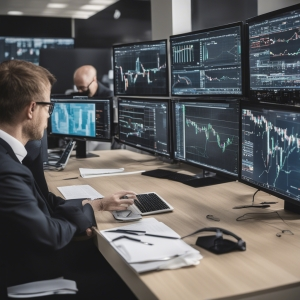Introduction to Backtesting Trading Strategies
If you're finding your way into the complex world of financial trading or cryptocurrencies, or have been dabbling in it for a while now, chances are you've heard a lot about how essential it is to have a solid, tested strategy. One term you'll come across in this context is 'Backtesting Trading Strategies.'
Backtesting is a crucial concept you need to grasp to navigate this world successfully. But what exactly is it, and why is it so important? Simply put, backtesting involves applying your trading strategy to historic data to see how it would have performed. It's much like a rehearsal for a play, testing the script before the actual performance.
Conducting thorough backtests allows traders to measure the effectiveness of their strategies before risking real money. However, it's important to remember that past performance is not always an accurate predictor of future results.
In this article, we aim to guide beginners through the nifty art of backtesting. We will explain how backtesting your trading strategies can help you validate and refine your plans, thus potentially boosting your profits. Get ready to delve into this fascinating topic and brace yourself for a large dose of financial education.
The Importance of Backtesting in Cryptocurrency Trading
So, why is backtesting trading strategies so crucial in the cryptocurrency market? Firstly, cryptocurrencies are known for their extreme volatility. The prices fluctuate drastically, making the crypto market an enticing, yet risky space for investors. Therefore, understanding how your trading strategy would have fared in the past becomes even more essential.
Secondly, just like in any other forms of trading, cryptocurrency trading is all about making informed decisions. Blindly deploying a strategy without understanding its potential outcomes can lead to huge losses. Backtesting helps avoid such pitfalls.
Lastly, backtesting helps traders create and adapt their strategies. With the insights gained from backtesting, traders can tweak their strategy to better align with the current market conditions. In a dynamic landscape like cryptocurrency trading, being adaptable to market conditions can be the difference between profit and loss.
However, the importance of backtesting lies not just in validating a trading strategy but also in understanding its limitations. It provides a reality check, and it's a great tool for learning and improving. Yet, it's only a part of the bigger picture, and shouldn't be relied upon solely to predict future market performance. It must be used in combination with other tools for effective trading.
Pros and Cons of Backtesting in Trading Strategy Validation
| Pros | Cons | |
|---|---|---|
| 1 | Helps validate effectiveness of a trading strategy before actual implementation | Takes time and resources to run numerous backtest simulations |
| 2 | Allows for refinement of trading strategies based on historical data | Historical data performance may not guarantee future results |
| 3 | Minimizes risk by uncovering potential issues in strategy | May lead to over-optimization or curve fitting, where a strategy is tailored too closely to past data and may not perform as well in the future |
| 4 | Can provide increased confidence in a trading strategy | Does not account for 'black swan' events or sudden market changes |
Defining the Art of Backtesting

Backtesting is often referred to as an art due to the critical role it plays in shaping effective trading strategies. The process of backtesting involves applying a trading strategy to historical market data and evaluating its performance, with the aim of forecasting the potential success of the strategy in real trading conditions.
It's a review of how a specific trading strategy would have fared if applied in the past. This retrospective analysis helps traders identify where their strategy would have excelled and where it would have encountered challenges. The information gleaned from backtesting can then be used to refine the strategy, improving its potential for future success.
The art of backtest lies in the integral back-and-forth between creating a strategy, testing it against historical data, analyzing the results, revising the strategy, and backtesting again. It is a repetitive and insightful process to optimize a trading strategy for the best possible outcomes. However, the art isn't solely in the repetition. The true artistry comes in interpreting the results, understanding the historical context, and applying the lessons learned to future trades.
Backtesting isn't a guaranteed prediction tool, but when performed correctly, it provides valuable insights to help traders make more informed decisions and potentially increase their chances of executing profitable trades.
Building a Sound Trading Strategy with Backtesting
A successful trading strategy begins with a clear understanding of your investment goals and risk appetite. You should have a firm grip on the kind of trades you wish to participate in and articulate a specific set of rules to govern your trading actions. However, even the most meticulously crafted trading strategy is just a speculation until it has been tested. This is where backtesting comes into play.
By simulating your trading strategy over a specific period in the past, backtesting helps you identify potential pitfalls and profitable opportunities. It allows you to anticipate different scenarios and prepare for them. Using the insights gleaned from backtesting, you can "debug" your strategy and fine-tune it to maximize your returns and minimize risks.
Let's take a simple example. Suppose you're a cryptocurrency trader who prefers to trade during periods of volatility, capitalizing on the sharp price swings to earn profits. Now, without backtesting, applying such a strategy could potentially lead to significant losses from unexpected price corrections. However, by backtesting this strategy over historical data, you can see how your strategy would have performed in real high-volatility situations. If the returns are not as per your expectations, you can adjust the strategy accordingly, perhaps by tightening your stop losses or entering trades only after confirming price trends.
It must be emphasized that backtesting is not a magic bullet. It merely provides a framework that allows you to understand your strategy better and improve it iteratively. It's essential to remember that while backtesting aims to simulate real market conditions, it can't perfectly replicate the future. Therefore, despite successful backtesting, always be prepared for surprises in the actual market trading and adjust your strategies dynamically.
To sum up, backtesting trading strategies is a comprehensive exercise that, when executed right, goes a long way in boosting your trading strategy's success odds. By offering an opportunity to validate your trading strategy and fine-tune it, backtesting empowers you to build sound trading strategies, reduce potential losses and increase your cryptocurrency trading success.
Understanding Common Backtesting Methods

Now that we've underscored the importance of backtesting trading strategies, let's delve into some common methods used by traders. Backtesting can be done in various ways, depending on the tools at your disposal and the complexity of your strategy.
At the simplest level, there is manual backtesting that can be done on a piece of paper or a spreadsheet. In this method, you go through historical data manually and apply your trading strategy to see how it would have performed. While this method is labor-intensive and time-consuming, it gives you a hands-on understanding of your strategy at work.
Next, there is automated backtesting, which uses specially designed software or programming scripts to apply your trading strategy to historic market data. The advantage of this method is that it provides quick results and is efficient for more complex strategies. However, it might not provide the level of detail and understanding you gain from manual backtesting.
Lastly, there is walk-forward testing or out-of-sample testing, which involves optimising your strategy on a certain set of data and then testing it on another different data. This method is more robust in simulating real market conditions as it covers different periods and scenarios.
No matter which method you opt for, the goal of backtesting remains the same. It's all about improving your chances of making successful trades by understanding how effective your strategy is likely to be in various scenarios. It enables you to refine and debug your strategy before you invest your hard-earned money.
Tips to Enhance the Effectiveness of Backtesting
Backtesting is a potent tool, but its benefits can only be reaped if it is used efficiently. Here are some tips that can help enhance the effectiveness of backtesting:
First and foremost, you should aim for accuracy – ensure the data you're backtesting your trading strategy on is accurate and clean. This is essential as inaccurate data can lead to flawed results, misguiding your trading decisions.
Secondly, take the time to define firm trading rules - vagueness can lead to unstable backtests, and multiple interpretations can cause confusion and generate misleading results.
Thirdly, remember to account for trading costs in your backtests. Costs like trading fees and slippage (discrepancy between the expected price of a trade and the price at which it is executed) can significantly impact your profits over time. By calculating these within your backtests, you can achieve a more realistic view of potential profits or losses.
Finally, consider conducting out-of-sample testing. That is, testing the strategy on a different data set than was used during the backtest. This allows you to validate your strategy further.
All these tips combined, can steer you towards creating a well-rounded and sound trading strategy, boosting your potential success in the world of cryptocurrency trading.
Guarding Against Potential Pitfalls in Backtesting

While backtesting is an indispensable tool in developing robust trading strategies, there are potential pitfalls that traders must be on guard against. These potential dangers could negate the utility of backtesting if not adequately addressed. We lay out a few of these pitfalls and how you can avoid them:
Firstly, over-optimization of your trading strategy is a common mistake. Over-optimization essentially entails tweaking your strategy obsessively based on past data in a bid to achieve the perfect outcome. While it may appear good on paper, it renders the strategy ineffective in a real, dynamic market. You must strike a balance between optimization and overfitting of your strategy.
Secondly, beware of curve fitting. Curve fitting involves adjusting your strategy based on past data in such a way that it fits perfectly with that historic data. This approach can prove misleading since it operates under the assumption that future market behaviour will mirror the past, which is often not the case.
Thirdly, remember that backtesting only makes use of historical data. The market is ever-evolving, influenced by numerous external factors. Past data, therefore, is just a part of the bigger picture and does not offer an absolute blueprint of future market behavior.
A useful approach is to maintain a critical perspective to avoid these traps and not to rely solely on backtesting. While it provides an important framework for evaluating your trading strategies, it should not be the only determinant of your trading decisions. Identifying these potential pitfalls is an essential step towards making the most of your backtesting efforts.
How Backtesting Contributes to Profitable Trading
So, how does backtesting trading strategies contribute to profitable trading? First and foremost, it provides an evidence-based way to assess the potential of a trading strategy. There's an old English saying, "Look before you leap." Backtesting essentially enables traders to "look" at the historical performance of their strategy before they "leap" into live trading.
Deciding to place a trade based merely on a gut feeling or a hot tip is as risky as it gets. Backtesting aims to replace this guesswork with quantitative data, providing a statistical basis for trading decisions. By revealing the success rate and profit possibility of a strategy under varied market conditions, it helps traders decide whether or not to implement it in real-time.
Secondly, backtesting helps in identifying and minimizing risks. The world of trading, particularly cryptocurrencies, is laden with risks. By studying how a strategy performs during bearish trends, for example, traders can understand the level of risk involved and make modifications accordingly.
Additionally, backtesting assists in optimizing a trading strategy. With the invaluable data it provides, traders can systematically fine-tune their strategies to better adapt to the market dynamics and improve their statistical chances of successful trades.
Ultimately, the venture of trading is largely about risk management. It about making decisions not just for the potential profits but also considering the risk involved. And it's in this aspect particularly where backtesting shines, making it an immeasurable asset in the quest for profitable trading.
Conclusion: The Role of Backtesting in Successful Trading
After diving into the world of backtesting trading strategies and realizing its impact on the creation and implementation of a sound trading plan, one thing stands clear: backtesting is an indispensable component of successful trading. Whether you're dabbling in traditional stocks or cryptocurrencies, backtesting offers a practical and data-driven way to validate and optimize your trading strategy.
Through comprehensive backtesting analysis, traders efficiently identify weaknesses and strengths in their trade execution plans, helping refine decision-making processes and refine risk management methods. Consequently, backtesting supplements the hands-on trading experience, making it an instrumental tool in a trader's arsenal.
While it's crucial to remember that backtesting doesn't guarantee future success, it offers invaluable lessons. It amplifies your understanding of the market and aids in making more informed and confident trading decisions. So, as you make your moves in the trading world, remember to master and utilize the art of backtesting!
By maintaining an adaptive mindset, a clear understanding of the limitations of backtesting, and a constant drive to learn, traders can harness the full power of backtesting and potentially open a pathway to steady and rewarding trades.
Frequently Asked Questions about Backtesting in Trading Strategies
What is Backtesting in Trading?
Backtesting in trading is a process where a trader validates their trading strategy using historical data. The aim is to simulate how a strategy would have performed in the past to gain insights into its potential future reliability.
Why is Backtesting Important in a Trading Strategy?
Backtesting is vital in a trading strategy to minimize the risk of loss. It helps in determining the profitability of a strategy before its live implementation, thereby improving the confidence of the trader.
What are the Key Elements of Backtesting?
Key elements of backtesting include the historical data set, the trading strategy to test, risk management or stop-loss rules, and the backtesting software or platform.
Can Backtesting Predict Future Performance?
While backtesting can provide valuable information, it cannot predict future performance. This is because the market is influenced by many unpredictable factors. Backtesting should thus be seen as a tool that provides insights into a strategy's potential rather than a forecast instrument.
What are the Limitations of Backtesting?
Backtesting has several limitations. It assumes that historical trends will repeat, which may not always be the case. Also, it doesn't take into account market impact, liquidity issues or changes in market conditions. Lastly, it may encourage overfitting, which means making a strategy overly complex and less reliable.







